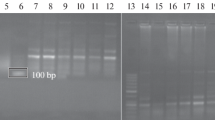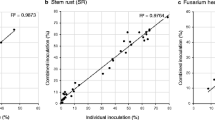Summary
Ten spring bread wheat cultivars with a susceptible seedling reaction to race 14E14 of yellow rust were tested at three locations to assess the level and stability of quantitative resistance. Quantitative resistance was expressed in terms of disease severity (DS), area under the disease progress curve (AUDPC), apparent infection rate (r), infection type (IT) and infection density. Large genotypic differences were observed for all variables measured. Morocco was the most susceptible cultivar. Based on its high infection type (IT=9) throughout the epidemics, it most likely does not possess any resistance. All other cultivars carry quantitative resistance. The levels ranged from very low (Taichung 23) to very high (Parula). Resistance levels were lower in Quito, Ecuador than at the other locations. Most likely, the lower temperatures in Quito resulted in a reduced expression of quantitative resistance to yellow rust and to obtain the same protection as at the other two locations, more resistance genes are needed. Therefore, to accumulate genes for quantitative resistance, Quito is considered to be the better location.
Though significant cultivar-location interactions were detected, they were small compared to the cultivar and location effect. Therefore, they are considered of little importance and it is concluded that quantitative resistance is a stable trait, in the sense that cultivar rankings are hardly affected by environment.
The contribution of infection growth to the development of yellow rust was demonstrated. Between 29 and 66% of the increase in disease severity could be contributed to growth of infections. These figures are probably an underestimation of the real contribution as new infections are very small, thus reducing the average size of infections and their contribution to the increase of disease severity.
Similar content being viewed by others
References
Badebo, A., R.W. Stubbs, M.van Ginkel & G. Gebeyehu, 1990. Identification of resistance genes to Puccinia striiformis in seedlings of Ethiopian and CIMMYT bread wheat varieties and lines. Netherlands Journal of Plant Pathology 96: 199–210.
Broers, L.H.M., 1989. Partial resistance to wheat leaf rust in 18 spring wheat cultivars. Euphytica 44: 247–258.
Broers, L.H.M. & J. Ochoa-Lozano, 1992. Expression of yellow rust resistance in CIMMYT germplasm at two highland locations. Vorträge für Pflanzenzüchtung 24: 267–269.
Broers, L.H.M. & J.E. Parlevliet, 1989. Environmental stability of partial resistance in wheat to wheat rust. Euphytica 44: 241–245.
Danial, D.L., L.H.M. Broers & J.E. Parlevliet, 1993. Does interplot interference affect the screening of wheat for yellow rust resistance? Euphytica 70: 217–224.
Dubin, H.J. & R. Johnson, 1989. Postulated genes for resistance to stripe rust in selected CIMMYT and related wheats. Plant Disease 73(6): 472–475.
Johnson, R., 1984. A critical analysis of durable resistance. Annual Review of Phytopathology 22: 309–330.
Johnson, R., 1988. Durable resistance to yellow (stripe) rust in wheat and its implication in plant breeding. In: N. W. Simmonds and S. Rajaram (Eds.). Breeding strategies for resistance to the rusts of wheat. CIMMYT, pp 63–75.
Johnson, R., R.W. Stubbs, E. Fuchs & N.H. Chamberlain, 1972. Nomenclature for physiological races of Puccinia striiformis infecting wheat. Transaction of the British Mycological Society 58: 475–480.
McNeal, F.H., C.F. Konzak, E.P. Smith, W.S. Tate & T.S. Russell, 1971. A uniform system for recording and processing cereal research data. ARS 34–121: 42pp.
Park, R.F. & R.G. Rees, 1989. Expression of adult plant resistance and its effect on the development of Puccinia striiformis f.sp tritici in some Australian wheat cultivars. Plant Pathology 38: 200–208.
Park, R.F., R.G. Rees & G.J. Platz, 1988. Some effects of stripe rust infection in wheat with adult plant resistance. Australian Journal of Agricultural Research 39: 555–562.
Parlevliet, J.E., 1988. Strategies for the utilization of partial resistance for the control of cereal rusts. In: N. W. Simmonds and S. Rajaram (Eds.). Breeding strategies for resistance to the rusts of wheat. CIMMYT, pp 48–62.
Peterson, R.F., A.B. Campbell & A.E. Hannah, 1948. A diagrammatic scale for estimating rust intensity of leaves and stems of cereals. Can J. Res. C26: 496–500.
Qayoum, A. & R.F. Line, 1985. High-temperature, adult-plant resistance to stripe rust of wheat. Phytopathology 75(10): 1121–1125.
Rees, R.G., J.P. Thompson & R.J. Mayer, 1979. Slow rusting and tolerance to rusts in wheat. I The progress and effects of epidemics of Puccinia graminis tritici in selected wheat cultivars. Australian Journal of Agricultural Research 30: 403–419.
Singh, R.P. & S. Rajaram, 1994. Genetics of adult plant resistance to stripe rust in ten spring bread wheats. 72: 1–7.
Steel, R.G.D. & J.H. Torrie, 1980. Principles and procedures of statistics. A biometrical approach. Mcgraw-Hill, Inc., Singapore. 633pp.
Stubbs, R.W., 1985. Stripe Rust. In: A. P. Roelfs and W. R. Bushnell (Eds.). The Cereal Rusts II. Academic Press, pp 61–101.
Stubbs, R.W., 1988. Pathogenicity analysis of yellow (stripe) rust of wheat and its significance in a global context. In: N. W. Simmonds and S. Rajaram (Eds.). Breeding strategies for resistance to the rusts of wheat. CIMMYT, pp 23–38.
Van der Plank, J.E., 1963. Plant diseases: Epidemics and control. Academic Press, New York. 349pp.
Van Ginkel, M. & S. Rajaram, 1993. Breeding for durable resistance to diseases in wheat: an international perpective. In: T. Jacobs and J. E. Parlevliet (Eds.). Durability of disease resistance. Kluwer Academic Publishers, pp 259–272.
Winer, P., 1984. Additive and multiplicative models for resistance in plant pathology. Euphytica. 33: 963–971.
Zadoks, J.C., T. Chang & C. Konzak, 1974. A decimal code for the growth stages of cereals. Weed Research 14: 415–421.
Zadoks, J.C. & R.D. Schein, 1979. Epidemiology and plant disease management. Oxford University Press, New York and Oxford. 427pp.
Zwer, K.P. & C.O. Qualset, 1994. Genes for resistance to stripe rust in four spring wheat varieties 2. Adult plant responses. 74: 109–115.
Author information
Authors and Affiliations
Rights and permissions
About this article
Cite this article
Broers, L.H.M., Cuesta Subias, X. & López Atilano, R.M. Field assessment of quantitative resistance to yellow rust in ten spring bread wheat cultivars. Euphytica 90, 9–16 (1996). https://doi.org/10.1007/BF00025154
Received:
Accepted:
Issue Date:
DOI: https://doi.org/10.1007/BF00025154




